by Lisa Cooke | Jun 4, 2016 | 01 What's New, Adoption, Listeners & Readers
This story of DNA for adoption research tells how one Genealogy Gems listener discovered biological roots that were closer to her adopted home than expected.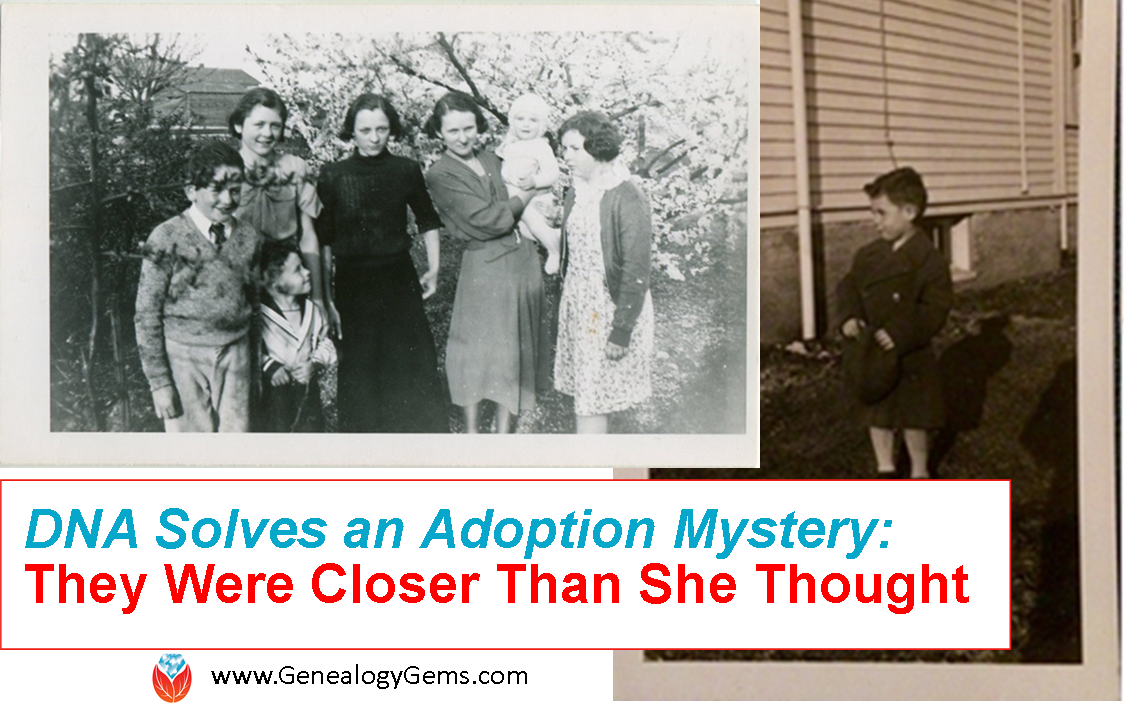
You never know what you’re going to learn when you start researching the biological roots of an adopted ancestor. And that was certainly the case for Katie from Pacifica, CA. Recently, she wrote me to share her story of researching an adopted ancestor. Understandably, people hope for a happy ending when using DNA for adoption research. But in Katie’s case, it may be just the beginning. Here’s why:
 “When I set out on this geni-journey, my goal was to find my grandfather’s birth parents. [He was adopted.] But as I read all the old family letters and newspaper clippings, I found myself getting so attached to his adoptive family. I was saddened that we weren’t blood-related, because I felt so connected and proud of them.
“When I set out on this geni-journey, my goal was to find my grandfather’s birth parents. [He was adopted.] But as I read all the old family letters and newspaper clippings, I found myself getting so attached to his adoptive family. I was saddened that we weren’t blood-related, because I felt so connected and proud of them.
My mother and I decided to take the AncestryDNA test, not sure what we’d find. When we got the results back, the strangest thing happened. My closest match with a family tree was a descendant of my grandfather’s adoptive grandfather.
My other closest match was adopted. He had been searching for his birth parents since the 1970s. When I called my adopted match, I think we were both excited and confused, not really sure how we’d be able to help each other in our search. As we compared notes, everything started clicking together. He began to cry. This mystery cousin of mine was no cousin at all. He was my grandfather’s half-brother. He was my great uncle, who was raised by a different, unrelated adoptive family!
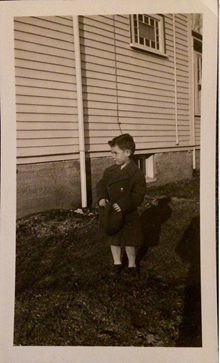
Katie’s grandfather at 4 years old, shortly after being adopted by Angela.
My grandfather, Joseph, turned out to be the biological nephew of his adoptive mother, Angela. His birth father was Angela’s brother, Paul. Angela’s own son tragically died of a ruptured appendix at age 4. Her husband, Ralph, was a merchant ship captain who traveled regularly all over the world, but most commonly between Oakland, CA and Brooklyn, NY.
According to family lore, less than a year after their son’s passing, Ralph mysteriously brought a freckly little boy (my grandpa) home to Oakland with him from Brooklyn, shocking his wife with this child she was suddenly expected to raise. Can you imagine that boat ride, all the way through the Panama Canal, as a confused orphan? And oh the family rumors that started!
Using DNA, we were able to put those rumors to rest. I’m not sure if Angela ever learned the truth– I’m not sure what Ralph told her, whether she even knew she was raising her own brother’s boy. All those years grandpa never asked who his birth parents were because he was afraid of hurting the family’s feelings, and little did he know he was being raised by his aunt the whole time. He probably met or at least wrote to his father without ever knowing it.
I have now met both my great half uncle, whose adoptive name is Bill (born Paul, in honor of his deceased birth father)– he lives in NY– and his son [Tom].
At 69 years old, that was his first time meeting a blood relative. I also connected with two living cousins in their 90s
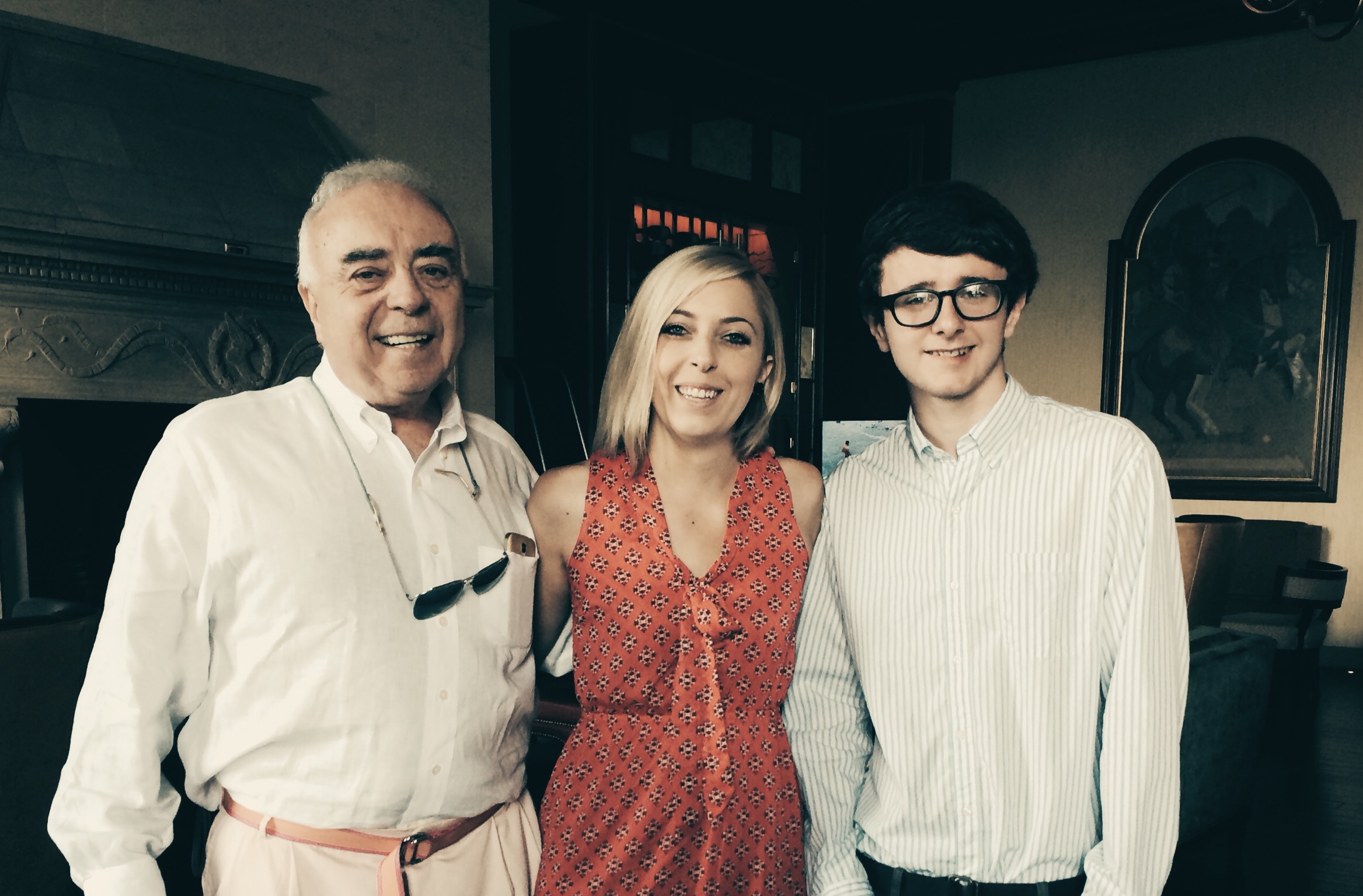
William Paul Nolan (left), born Paul Toomey, and his son, Tom (right), meeting Katie, their first known blood relative.
thanks to their very sweet children and nieces. I had photos of them from 1935, standing with my grandfather when he was only four years old, having no idea who they were until I started doing research.
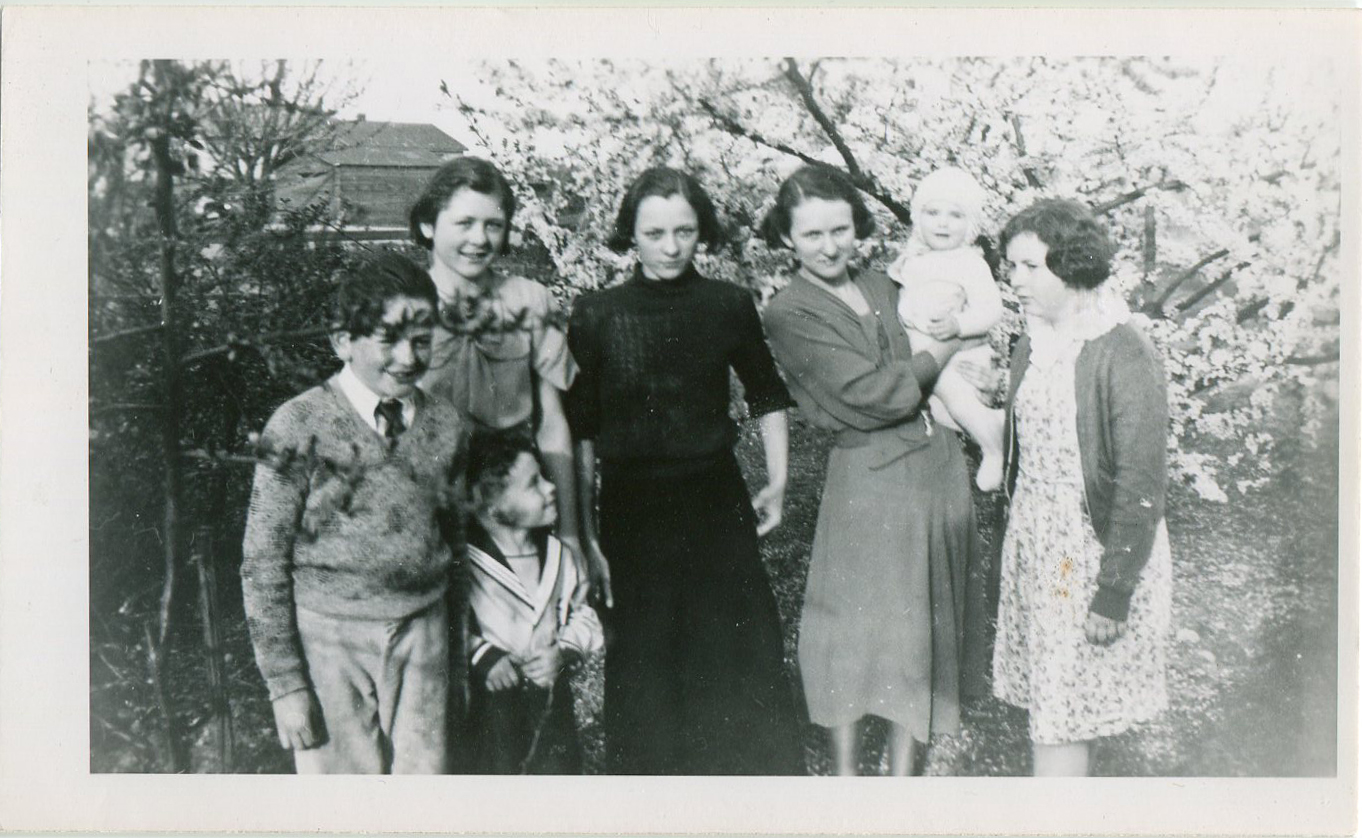
Katie’s grandfather as a little boy (in the sailor suit, second from left) with his adoptive first cousins (who were of blood relation), including Jack (10) and Loretta McKinnon (13). On the right is Katie’s grandfather’s adoptive sister (who would have been his first cousin by birth), Clare.
I couldn’t believe they were still around! I was able to meet them last year. I was also able to provide them with photos of their father, as they had only
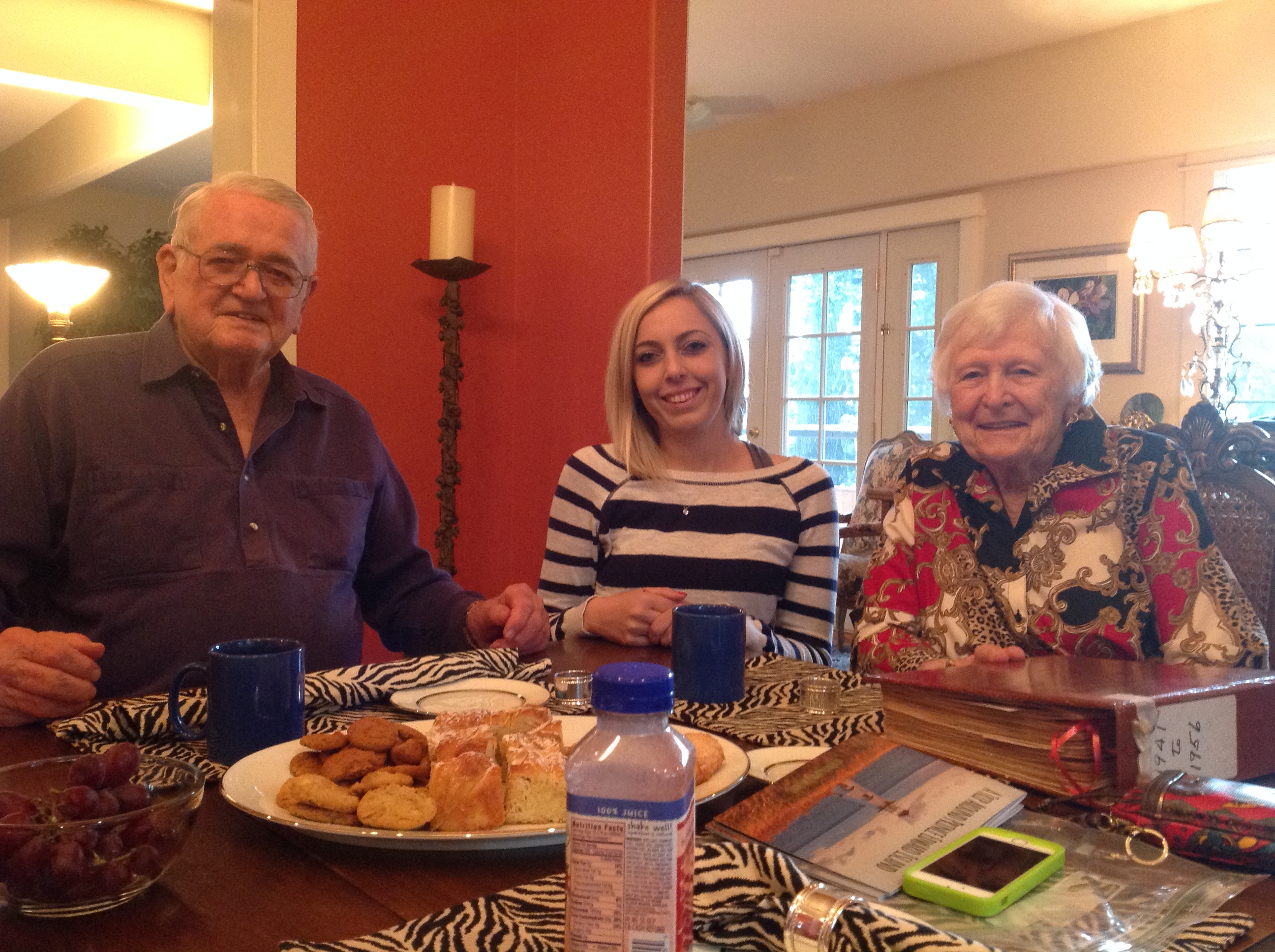
Jack (90, left) and Loretta (93, right) McKinnon meet Katie for the first time in 2015, 80 years after the photo with her grandfather was taken.
a few of their own.
I now send regular emails to the whole reunited family to update them on my genealogy discoveries.
I went on an homage journey to Prince Edward Island, the place my adoptive and birth great grandparents grew up, and was able to lay flowers at the gravestones of our long lost family members. The house they grew up in was still standing. Still being lived in, even!
It was such an amazing discovery after feeling so mysteriously close to that family, to know that it wasn’t all in my head. And to find out I had an uncle still living? Amazing.”
When Katie’s story landed in my inbox, it reminded me how lucky I am that so many of you share your personal, and inspiring stories! Thank you to Katie for giving us permission to share this inspiring story about using DNA for adoption research. You can read more about her family history adventures at her blog called McKinnon Ancestry.
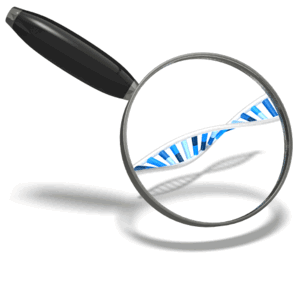 More DNA for Adoption Gems
More DNA for Adoption Gems
DNA for Adoption Research: Nice to Meet You!
Genealogy Gems Podcast episode 178: CeCe Moore Talks about Genealogy and Adoption (Listen for free)
DNA Testing for Adoptees: Advice from Your DNA Guide
by Lisa Cooke | Jun 3, 2016 | 01 What's New, Records & databases
Here are this week’s fabulous list of new genealogy records online. Included are records for Australia, Great Britain, United States, and the Philippines.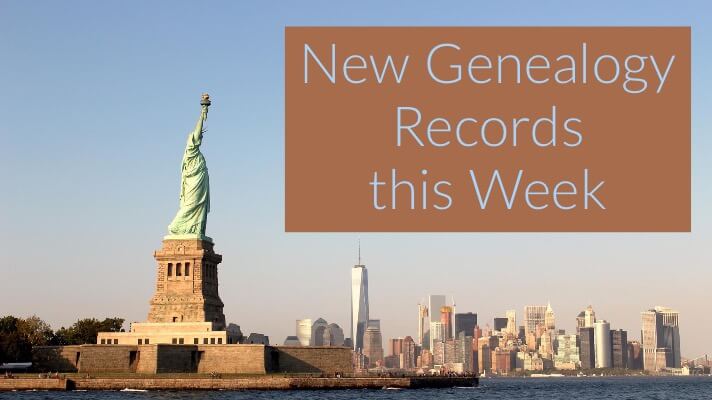
AUSTRALIA – REGISTER OF INMATES. The Ballarat Benevolent Society Register of Inmates for 1860-1897 is an ongoing project by Brett Weinberg. This register is a transcription and can be viewed on the Ballarat Historical Society website. The list of inmates from the Ballarat Benevolent Asylum in Victoria, Australia are in alphabetical order. The index provides details of age, birth place, parents names, residence, arrival date in Victoria and any additional remarks.
GREAT BRITAIN – MILITARY. The British Royal Navy & Royal Marines Service and Pension Records 1704-1919 are available at Findmypast. These records include the original service and pension records of those serving in the British Royal Navy and Marines. Information may include name, discharge date, death date, next of kin, and parish.
UNITED STATES – IOWA – MILITARY. Membership records of the Department of Iowa Grand Army of the Republic are now free to search on FamilySearch.org. The records are arranged by county and then by posts within each county. The records include veteran’s name, residence, occupation, date and place of birth, date and place of death, cemetery where buried, war record, dates of enlistment and discharge, names of parents, spouse, and children (if given.)
PHILIPPINES – MANILA – CIVIL REGISTRATION. The Manila Philippines Civil Registration for 1899-1984 at FamilySearch.org includes images of births, marriages, and deaths. This collection is only partially indexed at this time and currently covers birth certificates between the years of 1900 to 1980.
UNITED STATES – INDIANA – BIRTH, DEATH, AND MARRIAGES. Three new databases for Indiana have been recently added to Ancestry. They are Indiana, Birth Certificates, 1907-1940; Indiana, Marriage Certificates, 1958-2005; and Indiana, Death Certificates, 1899-2011. Each database offers digital images of these certificates and are jam packed with great genealogy data for your family tree!
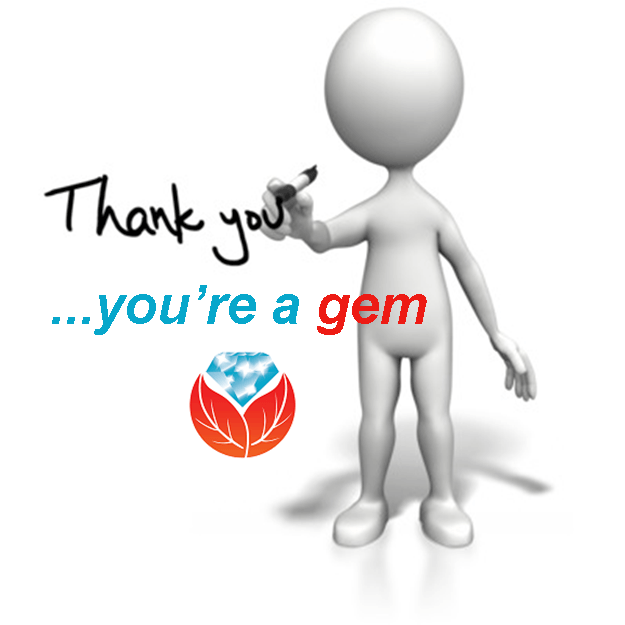 Thank you for sharing this list with your favorite genealogy gurus! We love sharing good news about new genealogy records online.
Thank you for sharing this list with your favorite genealogy gurus! We love sharing good news about new genealogy records online.
by Lisa Cooke | May 29, 2016 | 01 What's New, Collaborate, Dropbox
Dropbox is my go-to tool for sharing files online. Here’s how to share folders on Dropbox, and an update on how Dropbox sharing has changed.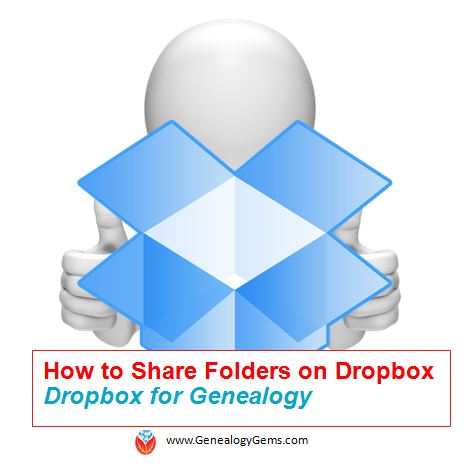
Dropbox is a favorite free tool of mine for sharing genealogy files online with family and fellow genealogists. It’s so frustrating to attach a file to an email only to discover that your email provider rejects it because it’s too big. And digital files (particularly video and high quality photographs) can be quite large. Dropbox solves the emailing problem.
Dropbox is cloud-based storage space where you can share most any files: family photos and videos, copies of your family stories, a PowerPoint slide show for your next family reunion, or research notes and to-do lists you’re working on with a team of fellow genies. Dropbox is especially great for files that are too large to email or that multiple people want to access and/or edit (without losing track of who has the most current version).
Here’s how to share folders on Dropbox (in Windows):
1. Log into (or create) your account at Dropbox.com.
2. From your list of folders, select the one you want to share by hovering the cursor over the folder’s name so the “Share” box appears on the right. (Don’t click on the folder name. That will open the folder.)

3. Click “Invite people to collaborate” if you want someone to be able to edit the folder and sync it (save it back to Dropbox in real time). Click “Share link” if you just want to let someone see the folder contents but not change them.
4. Enter the email address(es) to share with where it says “Invite members to this folder.” Add a personalized message if you like. Then hover over “can edit” if you want to change that option to “can view” only. As shown below, the system automatically allows those who can edit to manage membership of the folder (such as invite others). Unclick that box to reserve that privilege for yourself.
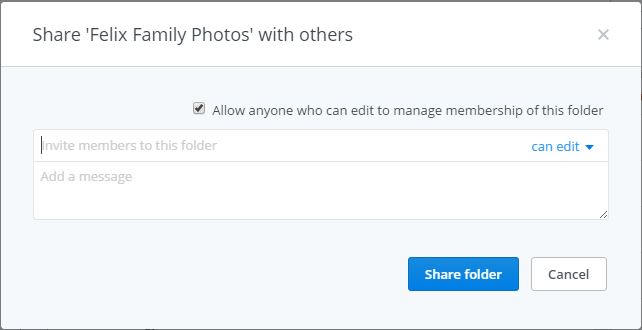
4. Once you’ve added everyone you want, click “Share folder.”
A Recent Dropbox Improvement
In the past, if you reorganized your Dropbox folders or any of the items in those folders, the links that you had previously sent out to other people would no longer work. Good news: shared links will now still work even if you move or rename the file or folder.
How to Unshare Files and Folders in Dropbox
Here’s more on file-sharing from Dropbox: “If you ever want to unshare something you’ve already sent out (like to remove access to a sensitive document), it’s easy to disable an active link.” After signing in, “Click the link icon next to the file or folder, and click ‘remove link’ in the top right corner of the box that appears. You can also remove the link by visiting dropbox.com/links and clicking ‘x’ next to the file or folder.”
More Gems on Dropbox for Genealogy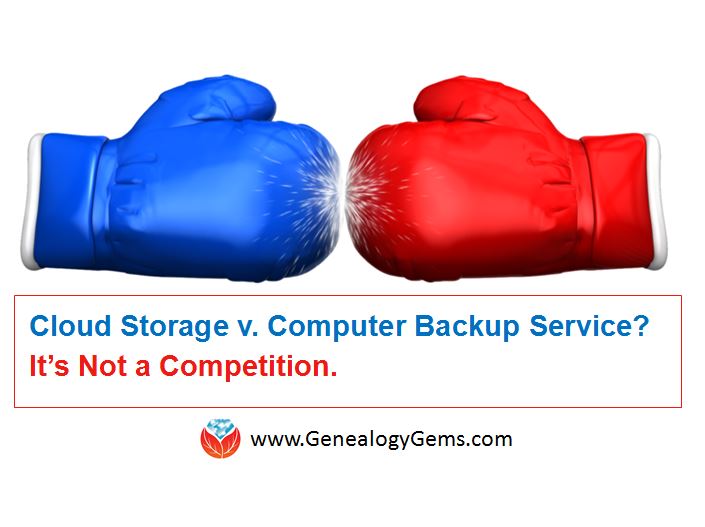
Dropbox v Backblaze: Does Cloud Storage for Genealogy Replace Computer Backup?
Genealogists’ Guide to Dropbox, a video presentation available to Genealogy Gems Premium members
Tips for Collaborative Genealogy: Research with a Partner
by Lisa Cooke | May 28, 2016 | 01 What's New, Publishing, Social Media, Writing Family History
Want to record your personal history but never seem to have the time? Turn Facebook posts into a book with this nifty service. It’s journaling for the twenty-first 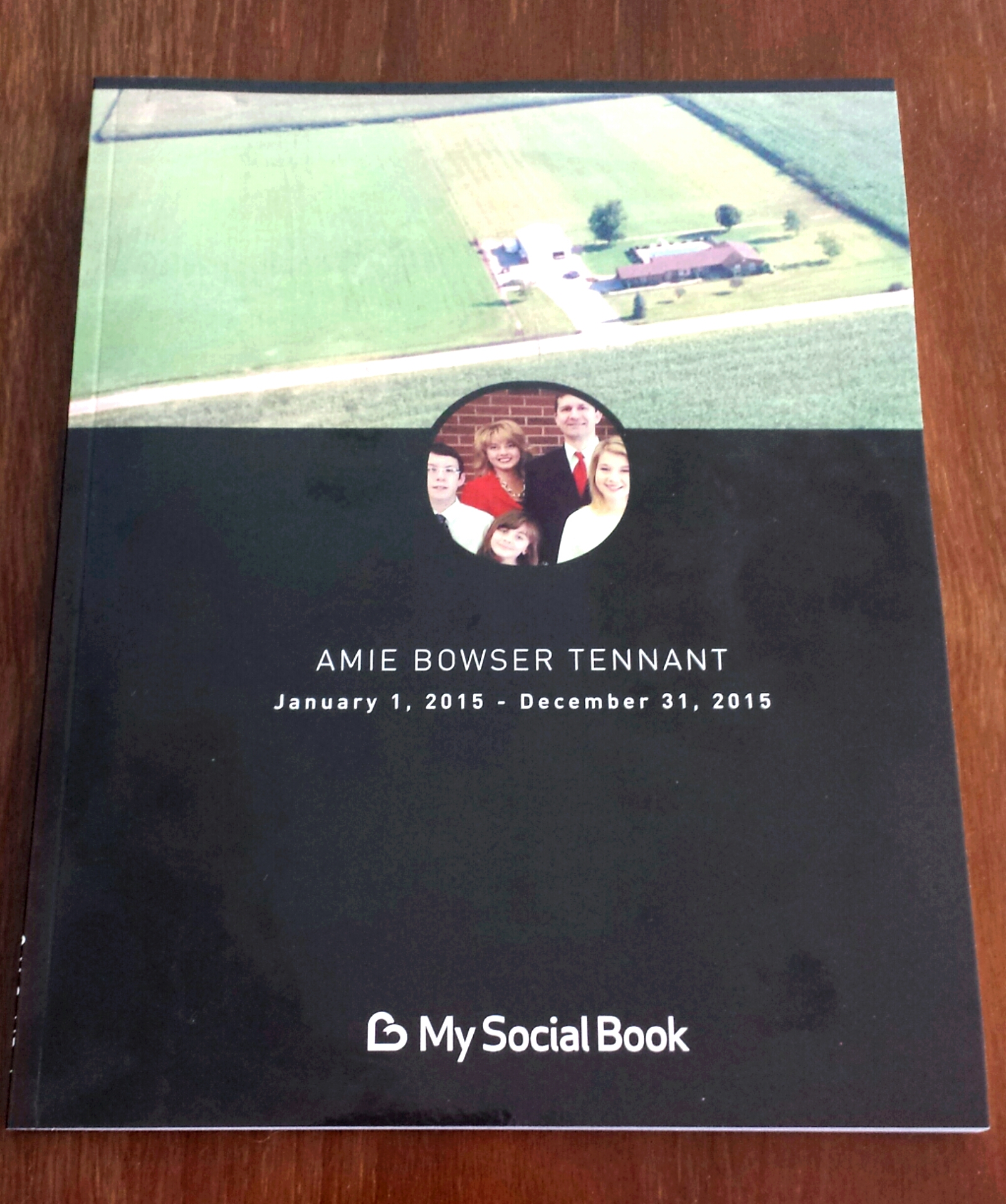 century!
century!
As a teenager, I was an avid journal writer. Now, it’s just one more thing I feel guilty about not doing regularly. But I have recently found an easy and effective solution: My Social Book.
Many of us already use Facebook to share the kinds of events we want to record, such as a grandchild’s kindergarten graduation, a weekend getaway, or a dinner out with friends. My Social Book will turn your Facebook posts into a book–complete with pictures and comments from your friends and family.
My Social Book.com slurps your Facebook statuses, comments, and photos and prints them as a lovely keepsake journal. In this context, slurping refers to an app or website “sucking” your content onto a new site with your permission. It is a wonderful tool.
Here’s How to Turn Facebook Posts into a Book
First, go to My Social Book.com and click “Start your book now.” Next, you will be able to edit your content by date and by posts. (If you want to leave out that silly post you made about your recent ailment, you can do that!)
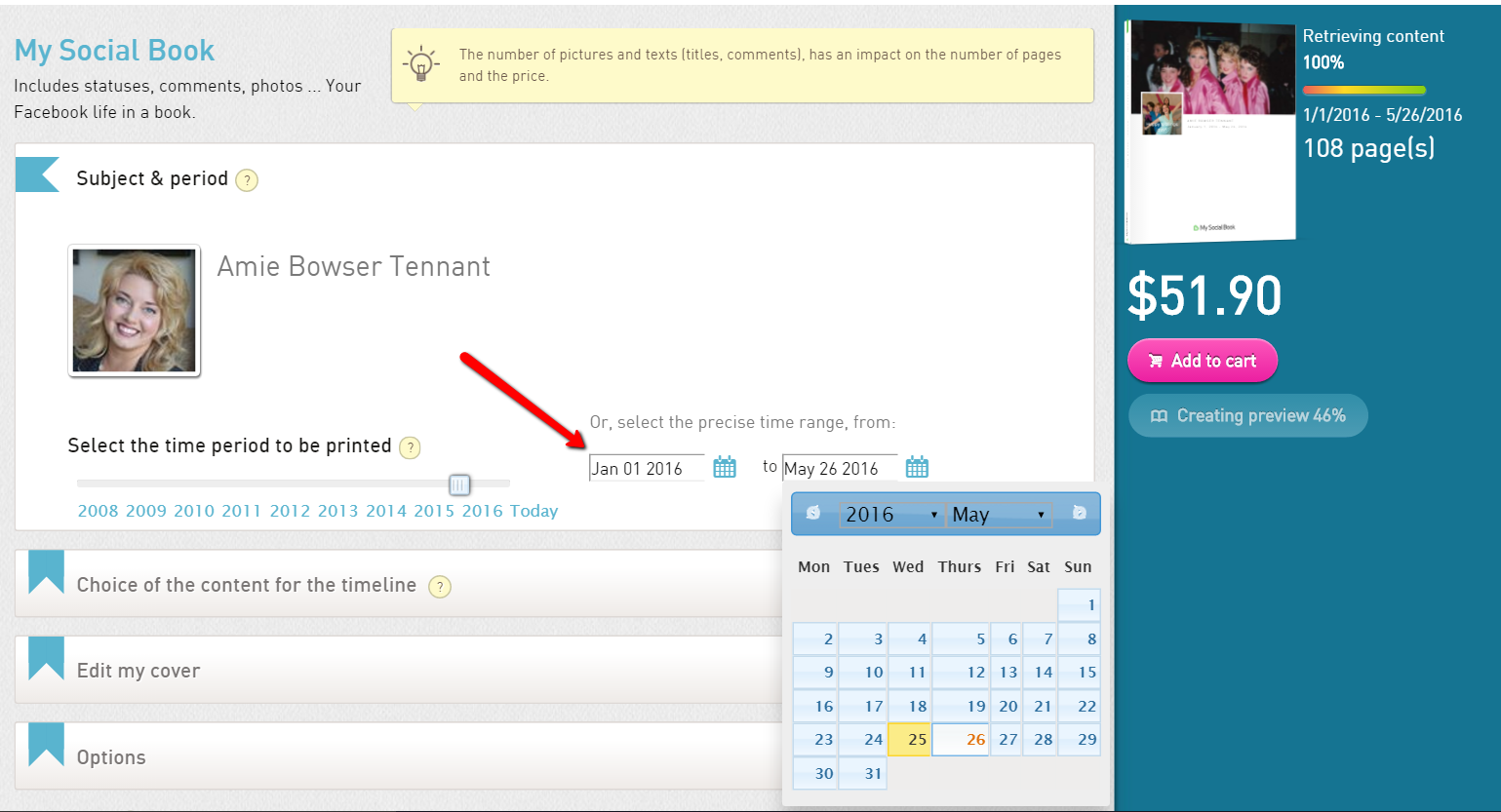
Choose from 16 different book cover colors and choose a soft or hard cover. When you are done, click “See inside” for a look at several of the personalized pages in your book. The final cost depends on the number of pages you included and your cover choice. My soft cover book with 108 pages cost $51.90. There is a small shipping and handling fee. (Tip: Google MySocialBook Coupon for free shipping and discounted prices on your first purchase.)
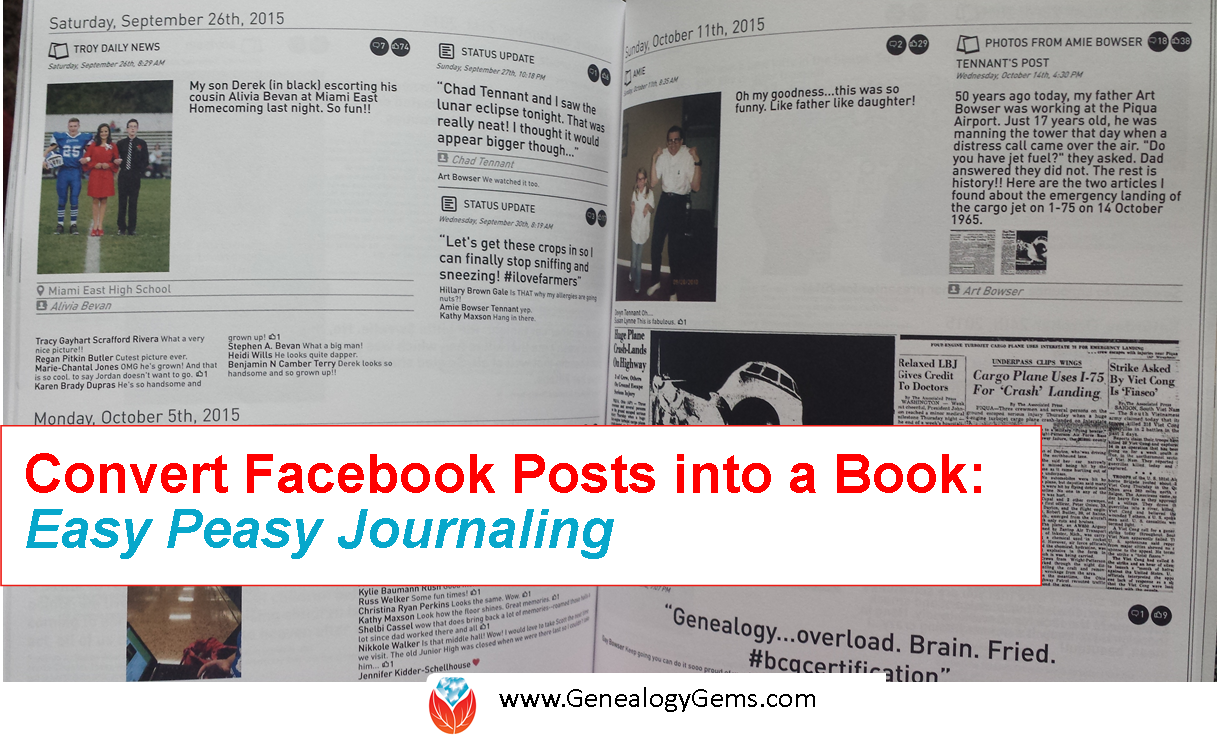 I was delighted with the book I ordered. I plan on ordering one each year. It was fun to read back over the year, see the pictures, and read the comments of my friends and loved ones. I think it will make a wonderful reading addition to the coffee table!
I was delighted with the book I ordered. I plan on ordering one each year. It was fun to read back over the year, see the pictures, and read the comments of my friends and loved ones. I think it will make a wonderful reading addition to the coffee table!
As a little side note, a friend of my mine passed away last year. I had forgotten how often she posted comments on my Facebook posts. It was a nice little reminder of her and I thought how neat it is to have the comments of our loved ones recorded in this way.
Don’t let another year go by without capturing your own personal history back from Facebook! My Social Book is a great answer to making time to keep a journal again.
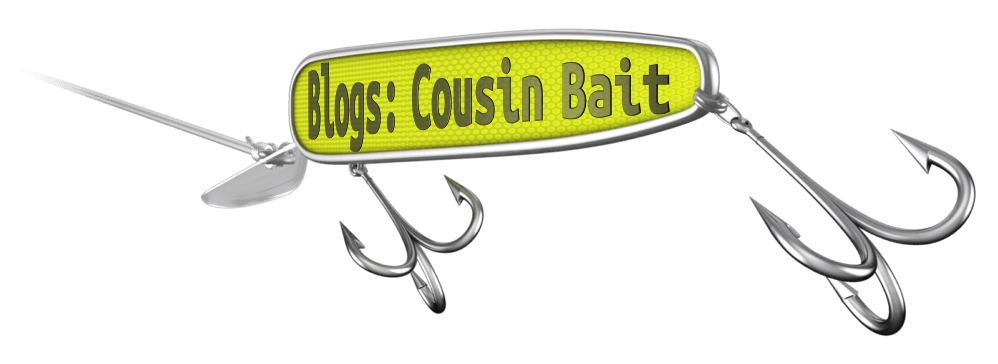 More Gems on Writing Family History
More Gems on Writing Family History
WHY and HOW to Start a Family History Blog
Easy Project to Write Your Family History
Famicity: A New Way to Gather and Share Family Stories
by Lisa Cooke | May 27, 2016 | 01 What's New
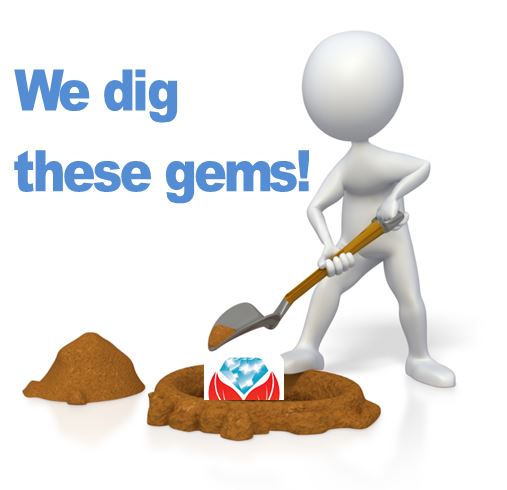 Here are this week’s collections of new genealogy records online. Included are Scotland mental health records and, in the U.S., WWII draft registrations, WI probate and NY marriages and deaths.
Here are this week’s collections of new genealogy records online. Included are Scotland mental health records and, in the U.S., WWII draft registrations, WI probate and NY marriages and deaths.
SCOTLAND – GLASGOW – MENTAL HEALTH. Arranged by county, the pages contain details of all licensed institutions operating in 1857 when a special report of the Royal Lunacy Commission was being prepared. The Mental Health Institutions Index will give you the information you need to order the entire record.
U.S. – MILITARY. Eight new states have been added to the U.S. World War II Draft cards, 1942 on Fold3.com. New states include North Carolina, Colorado, Arizona, Pennsylvania, Maryland, Delaware, New Mexico, Washington DC, and the U.S. Virgin Islands. These draft cards are a collection of The Fourth Registration, also known as “old man’s registration.” Men participating in this draft were born on or between 28 April 1877 and 16 February 1897.
U.S. – WISCONSIN- PROBATE. Wisconsin, Wills and Probate Records for 1800-1987 have been updated at Ancestry.com. This collection includes images of probate records for approximately 50 percent of Wisconsin counties. Wills, Letters of Administration, Guardianships, Inventories, and Bonds are just a few of the great gems you will buy erectile dysfunction medication online find there!
U.S. – NEW YORK- MARRIAGES. FamilyTree.com is offering a new digital index for New York City marriages, 1908-1938. This index is free and open to the public. Once you have found an ancestor using this index, you can write to the NYC Clerk to request a copy of the full record for $10.00. A full record may inlcude the marriage record, applications, affidavits, and licenses.
U.S. – NEW YORK – DEATHS. Our friend at Extreme Genes let us know about the recent addition of the 1966 deaths for New York State Death Index. Free and available online, this database covers deaths in New York State for 1957 – 1966. Decedents name, sex, date of death, and age at death are given in the index.
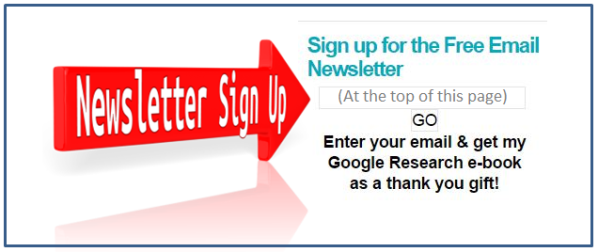 Be sure to check in next week to see what’s new in genealogy collections. Afraid you will miss the post? Sign up for Lisa’s free weekly e-newsletter so you will get future updates. Just enter your email address in the signup box at the top of this webpage. You’ll also receive a free e-book with Lisa Louise Cooke’s Google search strategies for genealogists.
Be sure to check in next week to see what’s new in genealogy collections. Afraid you will miss the post? Sign up for Lisa’s free weekly e-newsletter so you will get future updates. Just enter your email address in the signup box at the top of this webpage. You’ll also receive a free e-book with Lisa Louise Cooke’s Google search strategies for genealogists.

 “When I set out on this geni-journey, my goal was to find my grandfather’s birth parents. [He was adopted.] But as I read all the old family letters and newspaper clippings, I found myself getting so attached to his adoptive family. I was saddened that we weren’t blood-related, because I felt so connected and proud of them.
“When I set out on this geni-journey, my goal was to find my grandfather’s birth parents. [He was adopted.] But as I read all the old family letters and newspaper clippings, I found myself getting so attached to his adoptive family. I was saddened that we weren’t blood-related, because I felt so connected and proud of them.


 More DNA for Adoption Gems
More DNA for Adoption Gems


 Thank you for sharing this list with your favorite genealogy gurus! We love sharing good news about new genealogy records online.
Thank you for sharing this list with your favorite genealogy gurus! We love sharing good news about new genealogy records online.



 century!
century!
 I was delighted with the book I ordered. I plan on ordering one each year. It was fun to read back over the year, see the pictures, and read the comments of my friends and loved ones. I think it will make a wonderful reading addition to the coffee table!
I was delighted with the book I ordered. I plan on ordering one each year. It was fun to read back over the year, see the pictures, and read the comments of my friends and loved ones. I think it will make a wonderful reading addition to the coffee table! More Gems on Writing Family History
More Gems on Writing Family History
 Be sure to check in next week to see what’s new in genealogy collections. Afraid you will miss the post? Sign up for Lisa’s free weekly e-newsletter so you will get future updates. Just enter your email address in the signup box at the top of this webpage. You’ll also receive a free e-book with Lisa Louise Cooke’s Google search strategies for genealogists.
Be sure to check in next week to see what’s new in genealogy collections. Afraid you will miss the post? Sign up for Lisa’s free weekly e-newsletter so you will get future updates. Just enter your email address in the signup box at the top of this webpage. You’ll also receive a free e-book with Lisa Louise Cooke’s Google search strategies for genealogists.


